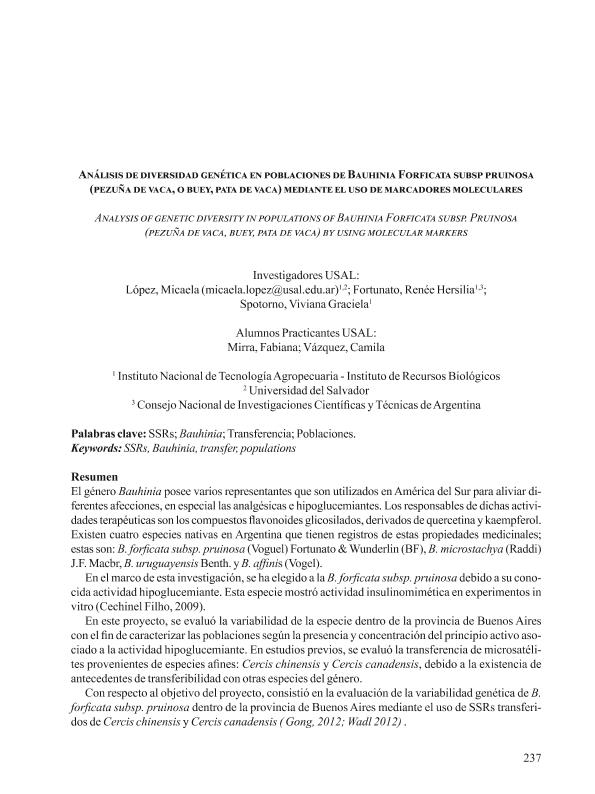Artículo
El género Bauhinia posee varios representantes que son utilizados en América del Sur para aliviar diferentes afecciones, en especial las analgésicas e hipoglucemiantes. Los responsables de dichas actividades terapéuticas son los compuestos flavonoides glicosilados, derivados de quercetina y kaempferol. Existen cuatro especies nativas en Argentina que tienen registros de estas propiedades medicinales; estas son: B. forficata subsp. pruinosa (Voguel) Fortunato & Wunderlin (BF), B. microstachya (Raddi) J.F. Macbr, B. uruguayensis Benth. y B. affinis (Vogel). En el marco de esta investigación, se ha elegido a la B. forficata subsp. pruinosa debido a su conocida actividad hipoglucemiante. Esta especie mostró actividad insulinomimética en experimentos in vitro (Cechinel Filho, 2009). En este proyecto, se evaluó la variabilidad de la especie dentro de la provincia de Buenos Aires con el fin de caracterizar las poblaciones según la presencia y concentración del principio activo asociado a la actividad hipoglucemiante. En estudios previos, se evaluó la transferencia de microsatélites provenientes de especies afines: Cercis chinensis y Cercis canadensis, debido a la existencia de antecedentes de transferibilidad con otras especies del género. Con respecto al objetivo del proyecto, consistió en la evaluación de la variabilidad genética de B. forficata subsp. pruinosa dentro de la provincia de Buenos Aires mediante el uso de SSRs transferidos de Cercis chinensis y Cercis canadensis ( Gong, 2012; Wadl 2012)... The Bauhinia genus has several representatives that are used in South America to alleviate various ailments, especially analgesic and hypoglycaemic ones. Glycosylated flavonoid compounds, derived from quercetin and kaempferol, are responsible for these therapeutic activities. There are four native species in Argentina that have records of these medicinal properties, these are: B. forficata subsp. pruinosa (Voguel) Fortunato & Wunderlin (BF), B. microstachya (Raddi) J.F. Macbr, B. uruguayensis Benth. and B. affinis (Vogel). Within the framework of this research, B. forficata subsp. pruinosa was chosen because of its known hypoglycaemic activity. This species showed insulino-mimetic activity in in-vitro experiments (Cechinel Filho, 2009). In this project, the variability of the species within the province of Buenos Aires was evaluated in order to characterise populations according to the presence and concentration of the active ingredient associated with hypoglycaemic activity. In previous studies, the transferability of SSRs from related species like Cercis chinensis y Cercis canadensis, was evaluated due to records of transferability between other species of the genus. The specific objective is to determine population variability of Bauhinia forficata subsp. pruinosa populations within Buenos Aires using SSRs transferred from Cercis chinensis and Cercis canadensis ( Gong, 2012; Wadl 2012) . Bauhinia samples were collected from different districts of the province of Buenos Aires and Córdoba, from which DNA was extracted (Dellaporta, 1983). In order to observe whether there is variability between populations linked to greater geographical distance, a population from Córdoba was included. The amplification of the microsatellite regions was carried out by PCR. SSRs markers consist of repetitions of 1, 2, 3 or 4 nucleotides of DNA present in the genome, and the differences between these repetitions make it possible to distinguish individuals and thus characterize populations. Through the chain reaction of the polymerase enzyme, known as PCR, it is possible to obtain a high number of copies of a DNA fragment that contains the SSRs, in order to visualize them using a technique that allows the DNA fragments to be separated by size, known as polyacrylamide gel electrophoresis. A set of 5 SSRs were analysed in 43 samples from Buenos Aires and Córdoba and another set of 5 SSRs were analysed in another 40 samples. These results show that there is intra and inter population variability. The high level of polymorphism exhibits that there might be a correlation between variability and biological activity. Hitherto, there is no molecular analysis of populations in Argentina. This data can be used in domestication programs and in active principle isolation protocols using biotechnology. This will make it possible to give added value to the country’s native flora, thus strengthening the regional and territorial development of the agricultural and agro-industrial system.
Análisis de diversidad genética en poblaciones de Bauhinia Forficata subsp pruinosa (pezuña de vaca, o buey, pata de vaca) mediante el uso de marcadores moleculares
Título:
Analysis of genetic diversity in populations of Bauhinia Forficata subsp. Pruinosa (pezuña de vaca, buey, pata de vaca) by using molecular markers
Lopez, Micaela; Fortunato, Renee Hersilia ; Spotorno, Viviana Graciela; Mirra, Fabiana; Vázquez, Camila
; Spotorno, Viviana Graciela; Mirra, Fabiana; Vázquez, Camila
 ; Spotorno, Viviana Graciela; Mirra, Fabiana; Vázquez, Camila
; Spotorno, Viviana Graciela; Mirra, Fabiana; Vázquez, Camila
Fecha de publicación:
12/2021
Editorial:
Universidad del Salvador
Revista:
Anuario de Investigación
ISSN:
2408-395X
e-ISSN:
2408-3968
Idioma:
Español
Tipo de recurso:
Artículo publicado
Clasificación temática:
Resumen
Palabras clave:
SSRS
,
BAUHINIA
,
TRANSFERENCIA
,
POBLACIONES
Archivos asociados
Licencia
Identificadores
Colecciones
Articulos(IBODA)
Articulos de INST.DE BOTANICA DARWINION (I)
Articulos de INST.DE BOTANICA DARWINION (I)
Citación
Lopez, Micaela; Fortunato, Renee Hersilia; Spotorno, Viviana Graciela; Mirra, Fabiana; Vázquez, Camila; Análisis de diversidad genética en poblaciones de Bauhinia Forficata subsp pruinosa (pezuña de vaca, o buey, pata de vaca) mediante el uso de marcadores moleculares; Universidad del Salvador; Anuario de Investigación; 6; 12-2021; 237-239
Compartir



